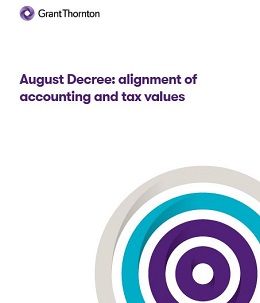-
Transactional advisory services
Find out more about the transactional advisory services of Grant Thornton Financial Advisory Services
-
Valuations
Find out more about the valuations services of Grant Thornton Financial Advisory Services
-
Mergers and acquisitions
Find out more about the merger and acquisition services of Grant Thornton Financial Advisory Services
-
Forensic and investigation services
Find out more about the forensic and investigation services of Grant Thornton Financial Advisory Services
-
Recovery & reorganisation
Find out more about the Recovery & reorganisation services of Grant Thornton Financial Advisory Services
-
Business risk services
Find out more about the business risk services of Grant Thornton Financial Advisory Services
-
Business consulting
Find out more about the business consulting services of Grant Thornton Financial Advisory Services
-
Capital market
Capital market
-
Corporate and business tax
Find out more about our corporate and business tax services.
-
Direct international tax
Find out more about our direct international tax services.
-
Global mobility services
Find out more about our global mobility services.
-
Indirect international tax
Find out more about our indirect international tax services.
-
Transfer pricing
Find out more about our transfer pricing services.
-
Litigation
Our lawyers and accountants can manage all defense measures provided not only by the Italian law, but also by EU regulations and conventions
-
Family business
Find out more about our Family business services.
-
Legal
The client can be assisted in every need and with the same care both on important operations or disputes and on simple matters

-
Back office outsourcing
Find out more about our Back office outsourcing services
-
Business process outsourcing
Find out more about our business process outsourcing services.
-
Compilation of financial statements
Find out more about our compilation of financial statements services.
-
Tax compliance
Find out more about our tax compliance services.
-
Electronic invoicing
Find out more about our electronic invoicing services
-
Electronic storage
Electronic storage is an archiving procedure that guarantees the legal validity of a digitally stored electronic document
-
Revaluation of corporate assets
Find out your civil and fiscal revaluation of tangible, intangible and financial assets
-
Payroll
Complete and customized payroll service, integrated with digital solutions and compliant with Italian and international regulations.
-
Labor consultancy
We help Italian and international companies manage all aspects of their workforce.
-
HR & Payroll Advisory Services
We review contracts, payroll, and risks for extraordinary transactions and we assess tax, labor, and safety risks in outsourcing contracts.
-
Extended services
We provide integrated digital tools to simplify HR management.
-
HR Infinity Portal
The HR Infinity Portal is Zucchetti’s platform designed to centralize communication between the company and its employees.
-
Cybersecurity
GT Digital helps clients structure information security management internal functions, also through partially or totally outsourced functions
-
Agile and Programme Management
GT Digital provides support in the adoption and implementation of different portfolio management
-
Robotic Process Automation
Our “BOT Farm” can rely on digital workers able to help clients in routine activities, allowing employees to deal with more added-value activities
-
Data strategy and management
GT Digital can support clients in seizing the opportunities offered by Big Data, from the definition of strategies to the implementation of systems
-
Enterprise Resource Planning
We support clients in selecting the most appropriate ERP System according to their specific needs, helping them also understand licensing models
-
IT strategy
GT Digital supports clients in making strategic choices, identifying innovation opportunities, comparing themselves with competitors
-
IT service management
We can support with software selection and with the implementation of dedicated tools for the management of ICT processes
-
DORA and NIS 2
The entry into force of the DORA Regulation and NIS2 represents a major step towards the creation of a harmonised regulatory framework
Art. 110 of Law Decree no. 104/2020 (so-called August Decree), besides the provisions on the revaluation of corporate assets, also extends the application of the provisions under art. 14 of Law no. 342/2000 concerning the possibility to realign tax values with accounting values. Para. 8 of the abovementioned article also extends such realignment possibility also to IAS/IFRS adopters.
The reasons underlying a misalignment between tax and accounting values could derive from different events, such as the adoption of the fair value option as first-time adopter or following M&A operations considered as neutral for tax purposes (e.g. assignments, mergers, demergers), or merely accounting revaluations made by applying former regulations.
Scope of application
The realignment concerns differences in value related to tangible and intangible fixed assets, provided that they are represented by legally protectable assets or rights, and therefore excludes commodities and goodwill from its scope.
As specified in Circular letter no. 14/2017, assets to be realigned must be included both in the previous FY and in the FY in which the realignment is carried out (similarly to what is provided on revaluation).
It is specified that subjects applying international accounting standards can opt for the realignment also with reference to participating interests in companies and entities that constitute financial fixed assets, even if they are not controlling or relevant interests, provided that they are not held for negotiation. Therefore, the realignment can be applied not only to tax values of controlling and relevant participating interests (IAS 27, IAS 28, and IAS 31), but also to those held in FVTPL (non-trading) portfolio, or, as an option, in the IFRS 9 FVTOCI portfolio.
The realignment can also be carried out on a single asset (without the need to apply it homogeneously per classes) but it cannot be partial, since it must concern the whole value difference.
Application procedure
The realignment is subject to the payment of a 3% substitute tax and is effective starting from the FY following that, which the realignment refers to (2021 for subjects whose FY corresponds to the solar year). Moreover, with the only aim to balance tax (lower) values with accounting (higher) values, the realignment – unlike what provided for revaluation – does not have particular reflections on financial statements items.
It is also pointed out that subjects opting for this possibility must lock up an (untaxed) reserve – already existing in the financial statements – corresponding to the higher realigned values, net of the 3% substitute tax.
However, this reserve can be released by paying a 10% substitute tax. The utilization of the “non-released” reserve will contribute to the calculation of the taxable income for the distributing company.

